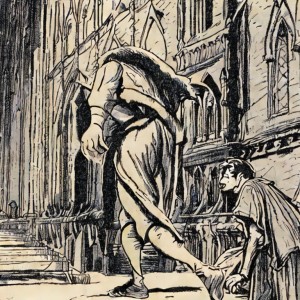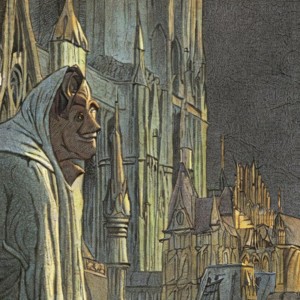The idea of the novel “The Hunchback of Notre-Dame” arose from Hugo in the early 20th century and finally took shape by the middle of 1828. The prerequisites for creating an epochal work were natural cultural processes that took place in France in the first third of the 19th century: historical literature was popular in literature, writers turned to the romantic atmosphere of the Middle Ages, and the public struggle for the protection of ancient architectural monuments in which Hugo took direct part. That is why we can say that one of the main characters of the novel, on a par with Esmaralda’s gypsy woman, Quasimodo ringer, archdeacon Claude Frollo, captain of the royal shooters Phoebus de Chateaupers and poet Pierre Gringoire himself is Notre Dame de Paris key events of the work.
In the work on the book, Victor Hugo was repelled by the literary experience of Walter Scott, a recognized master of historical novels. At the same time, the French classic already understood that society needs something more lively than its English colleague could offer, operating with typical characters and historical events. According to Victor Hugo, it should have been “… at the same time a novel, drama and epic, of course, picturesque, but at the same time poetic, real, but at the same time perfect, truthful, but at the same time the same time majestic ”(magazine French Muse, 1823).
“The Hunchback of Notre-Dame” became exactly the novel the French writer dreamed of. He combined the features of the historical epic, romantic drama and psychological novel, telling the reader the incredible private life of different people, taking place against the background of specific historical events of the XV century.
The chronotope of the novel, organized around Notre Dame de Paris – a unique architectural monument that combines the features of Romanesque and Gothic architecture – includes Paris streets, squares and districts running from it in all directions (Cathedral and Grevskaya Square, University, “Courtyard of Miracles”, etc.). Paris in the novel becomes a natural continuation of the Cathedral, towering over the city and protecting its spiritual and social life.
Notre Dame de Paris, like most ancient architectural monuments, according to Hugo, is embodied in stone by the Word – the only restraining force for rude, uneducated people in Paris. The spiritual authority of the Catholic Church is so great that it easily turns into a refuge for Esmeralda, who is accused of witchcraft. The inviolability of the temple of the Mother of God is violated by royal arrows only on the orders of Louis XI, who prayed for permission from his heavenly patroness and promised to donate a beautiful silver statue to her for this act. The French king has nothing to do with Esmeralda: he is only interested in the revolt of the Parisian rabble, who, in the opinion of Louis XI, decided to kidnap a sorceress from the Cathedral in order to bring her to death. The fact that people seek to free their sister and get hold of at the expense of church wealth does not occur to either the king or his confidants, which is an excellent illustration of the political isolation of power from the people and a lack of understanding of its needs.
The main characters of the novel are closely related to each other not only the central love theme, but also their affiliation to Notre Dame de Paris: Claude Frollo is the archdeacon of the temple, Quasimodo is a bell ringer, Pierre Gringoire is a disciple of Claude Frollo, Esmeralda is a dancer performing on Cathedral Square, Phoebus de Chateaupers – the bridegroom of Fleur-de-Lys de Gondelorie, who lives in the house, whose windows overlook the Cathedral.
At the level of human relationships, the characters intersect with each other through Esmeralda, whose artistic character is plot-forming for the whole novel. Everyone’s attention is riveted on the beautiful Gypsy in “Notre Dame de Paris”: Parisian citizens enjoy admiring her dances and tricks with the snow-white goat Jali, local mob (thieves, prostitutes, imaginary beggars and cripples) revere her no less than the Virgin, the poet Pierre Gringoire and the captain of the royal shooters Phoebus are physically attracted to her, the priest Claude Frollo has a strong desire, Quasimodo has love.
Esmeralda herself – a pure, naive, virgin child – gives her heart to an outwardly beautiful, but internally ugly Phoebe. The love of a girl in a novel is born out of gratitude for salvation and freezes in a state of blind faith in her lover. Esmeralda is blinded by love so much that she is ready to blame Phoebus for being cold, who confessed under torture of killing the captain under torture.
The young handsome Phoebe de Chateaupers is a noble person only in the company of women. Alone with Esmeralda – he is a lying seducer, in the company of Jean Miller (Claude Frollo’s younger brother) – a fair amount of foul language and a drinker. Phoebus by itself is the usual Don Juan, brave in battle, but cowardly when it comes to his good name. The exact opposite of Phoebus in the novel is Pierre Gringoire. Despite the fact that his feelings for Esmeralda are devoid of particular elevation, he finds the strength to recognize the girl as a sister rather than as a wife, and with time to love in her not so much a woman as a man.
The personality in Esmeralda is also seen by an unusually scary bell ringer of Notre Dame de Paris. Unlike other heroes, he draws attention to the girl no sooner than she takes care of him, by giving Quasimodo water standing at the infamous pillar. Only having known the good soul of the gypsy, the hunched ugly begins to notice her physical beauty. The external discrepancy between himself and Esmeralda Quasimodo is going through quite courageously: he loves the girl so much that he is ready to do everything for her – not to show his eyes, bring another man, protect him from the angry crowd.
Archdeacon Claude Frollo is the most tragic character of the novel. Associated with it is the psychological component of “Notre Dame de Paris”. A well-educated, just, God-loving priest, having fallen in love, turns into a real Devil. He wants to make Esmeralda’s love at all costs. Inside it, there is always a struggle between good and evil. The archdeacon then begs the gypsy for love, then tries to take her by force, then saves her from death, then he himself hands her to the executioner. A passion that does not find a way out ultimately kills Claude himself.

